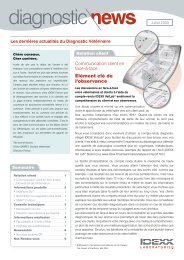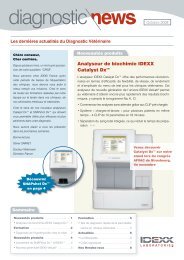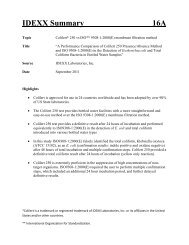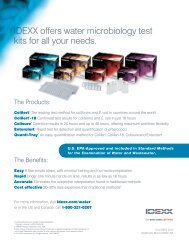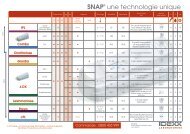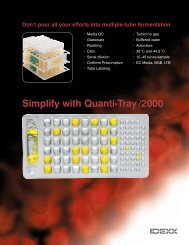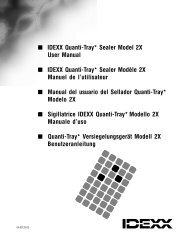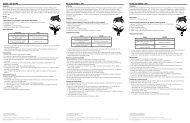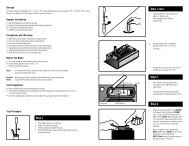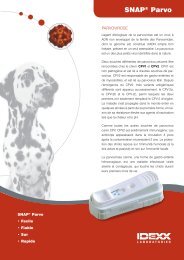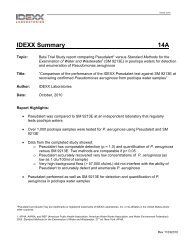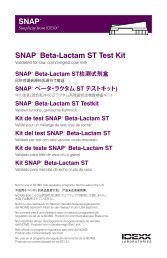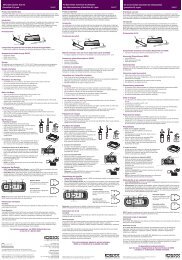Colilert*-18 Test Kit Kit d'analyse Colilert - IDEXX Laboratories
Colilert*-18 Test Kit Kit d'analyse Colilert - IDEXX Laboratories
Colilert*-18 Test Kit Kit d'analyse Colilert - IDEXX Laboratories
Create successful ePaper yourself
Turn your PDF publications into a flip-book with our unique Google optimized e-Paper software.
<strong><strong>Colilert</strong>*</strong>-<strong>18</strong> <strong>Test</strong> <strong>Kit</strong><br />
Introduction<br />
<strong>Colilert</strong>-<strong>18</strong> either simultaneously detects total coliforms and E. coli; or fecal coliforms in water. It is based on <strong>IDEXX</strong>’s patented Defined Substrate Technology*<br />
(DST*). When total or fecal coliforms metabolize <strong>Colilert</strong>-<strong>18</strong>’s nutrient-indicator, ONPG, the sample turns yellow. When E. coli metabolize <strong>Colilert</strong>-<strong>18</strong>’s<br />
nutrient-indicator, MUG, the sample also fluoresces. <strong>Colilert</strong>-<strong>18</strong> can simultaneously detect these bacteria at 1 cfu/100 mL within <strong>18</strong> hours even with as many<br />
as 2 million heterotrophic bacteria per 100 mL present.<br />
Storage<br />
Store at 2-25°C away from light.<br />
Presence/Absence (P/A) Procedure<br />
1. Add contents of one pack to a 100 mL sample in a sterile, transparent, nonfluorescing vessel.<br />
2. Cap vessel and shake.<br />
3. If sample is not already at 33–38°C, then place vessel in a 35°C waterbath for 20 minutes<br />
or, alternatively, a 44.5°C waterbath for 7–10 minutes.<br />
4. Incubate at 35±0.5°C for the remainder of the <strong>18</strong> hours.<br />
5. Read results according to Result Interpretation table below.<br />
Quanti-Tray* Enumeration Procedure<br />
1. Add contents of one pack to a 100 mL room temperature water sample in a sterile vessel.<br />
2. Cap vessel and shake until dissolved.<br />
3. Pour sample/reagent mixture into a Quanti-Tray or Quanti-Tray/2000 and seal in an <strong>IDEXX</strong> Quanti-Tray Sealer.<br />
4. Place the sealed tray in a 35±0.5°C (or 44.5±0.2°C for fecal coliforms) incubator for <strong>18</strong> hours<br />
(prewarming to 35°C is not required). For incubation in a water bath, submerge the Quanti-Tray, as is, below the<br />
water level using a weighted ring.<br />
5. Read results according to the Result Interpretation table below. Count the number of positive wells and refer<br />
to the MPN table provided with the trays to obtain a Most Probable Number.<br />
Result Interpretation<br />
Appearance<br />
Less yellow than the comparator 1 when incubated<br />
at 35±0.5°C or 44.5±0.2°C<br />
Yellow equal to or greater than the comparator<br />
when incubated at 35±0.5°C<br />
Yellow equal to or greater than the comparator<br />
when incubated at 44.5±0.2°C<br />
Yellow and fluorescence equal to or greater than<br />
the comparator when incubated at 35±0.5°C<br />
Result<br />
Negative for total coliforms and E. coli;<br />
Negative for fecal coliforms<br />
Positive for total coliforms<br />
Positive for fecal coliforms<br />
Positive for E. coli<br />
• Look for fluorescence with a 6-watt, 365-nm UV light within 5 inches of the sample in a dark environment. Face light away from your eyes and<br />
towards the sample.<br />
• <strong>Colilert</strong>-<strong>18</strong> results are definitive at <strong>18</strong>–22 hours. In addition, positives for both total coliforms and E. coli or fecal coliforms observed before <strong>18</strong> hours and<br />
negatives observed after 22 hours are also valid.<br />
Procedural Notes<br />
• A slight tinge may be observed when <strong>Colilert</strong>-<strong>18</strong> is added to the sample.<br />
• If excess foam causes problems while using Quanti-Tray, you may choose to use <strong>IDEXX</strong> Antifoam Solution (Catalog# WAFDB) or <strong>IDEXX</strong> 120 ml vessels<br />
with Antifoam (Catalog# WV120SBAF-200).<br />
• This insert may not reflect your local regulations. For compliance testing, be sure to follow appropriate regulatory procedures. For example, samples run in<br />
Europe should be incubated at 36±2°C for <strong>18</strong>-22 hours.<br />
• When following AFNOR validated method for drinking water testing, place the sealed tray in a 36±2°C incubator for <strong>18</strong> hours (prewarming to 36°C is not<br />
required).<br />
• <strong>Colilert</strong>-<strong>18</strong> can be run in any multiple tube format. Standard Methods for the Examination of Water and Wastewater 2 MPN tables should be used to find<br />
Most Probable Numbers (MPNs).<br />
• If a water sample has some background color, compare inoculated <strong>Colilert</strong>-<strong>18</strong> sample to a control blank of the same water sample.<br />
• <strong>Colilert</strong>-<strong>18</strong> can be used for E. coli detection (but not coliforms) in marine water. Samples must be diluted at least tenfold. Multiply the MPN value by the<br />
dilution factor to obtain the proper quantitative result.<br />
• Use only sterile, nonbuffered, oxidant-free water for dilutions.<br />
• <strong>Colilert</strong>-<strong>18</strong> is a primary water test. <strong>Colilert</strong>-<strong>18</strong> performance characteristics do not apply to samples altered by any pre-enrichment or concentration.<br />
• In samples with excessive chlorine, a blue flash may be seen when adding <strong>Colilert</strong>-<strong>18</strong>. If this is seen, consider sample invalid and discontinue testing.<br />
• Aseptic technique should always be followed when using <strong>Colilert</strong>-<strong>18</strong>. Dispose of in accordance with Good Laboratory Practices.<br />
Quality Control Procedures<br />
The following quality control procedure is recommended for each lot of <strong>Colilert</strong>-<strong>18</strong> when used for total coliform and E. coli testing at 35±0.5°C:<br />
1. Fill three sterile vessels with 100 mL sterile water and inoculate one with an E. coli, one with a total coliform and one with a non-coliform using one of the<br />
following products :<br />
A. Quanti-Cult* 3 E. coli, Klebsiella pneumoniae and Pseudomonas aeruginosa<br />
B. A sterile loop of ATCC 4 strains, E. coli ATCC 25922 or 11775, Klebsiella pneumoniae ATCC 31488 and Pseudomonas aeruginosa ATCC 10145 or 27853<br />
2. Follow the P/A Procedure or Quanti-Tray Enumeration Procedure above.<br />
3. Results should match the Result Interpretation table above.<br />
The following quality control procedure is recommended for each lot of <strong>Colilert</strong>-<strong>18</strong> when used for fecal coliform testing at 44.5±0.2°C:<br />
1. Fill two sterile vessels with 100 mL sterile water and inoculate one with a fecal coliform (E. coli) and one with a non-fecal coliform (Pseudomonas aeruginosa)<br />
using the following strains:<br />
• A sterile loop of ATCC strains, E. coli ATCC 25922 or 11775 and Pseudomonas aeruginosa ATCC 10145 or 27853<br />
2. Follow the Quanti-Tray Enumeration Procedure above.<br />
3. Results should match the Result Interpretation table above.<br />
<strong>Kit</strong> d’analyse <strong><strong>Colilert</strong>*</strong>-<strong>18</strong><br />
Introduction<br />
<strong>Colilert</strong>-<strong>18</strong> permet de détecter dans l’eau soit la présence de coliformes totaux et de bactéries E. coli, soit la présence de coliformes fécaux. Ce test est<br />
basé sur la technologie brevetée Defined Substrate Technology* (DST*) d’<strong>IDEXX</strong>. Lorsque les coliformes totaux ou fécaux métabolisent ONPG, le substrat<br />
chromogène-indicateur de <strong>Colilert</strong>-<strong>18</strong>, l’échantillon vire au jaune. Lorsque l’échantillon est positif, le réactif MUG contenu dans <strong>Colilert</strong>-<strong>18</strong> est métabolisé par<br />
les E. coli et génère une fluorescence. <strong>Colilert</strong>-<strong>18</strong> peut détecter simultanément ces bactéries à 1 cfu/100 ml en <strong>18</strong> heures, même en présence de bactéries<br />
hétérotrophes à une concentration de 2 millions par 100 ml.<br />
Conditions de conservation<br />
Conserver entre 2–25°C à l’abri de la lumière.<br />
Procédure de Présence/Absence (P/A)<br />
1. Ajouter le contenu d’un sachet dans un prélèvement de 100 ml placé dans un récipient<br />
stérile, transparent et non fluorescent.<br />
2. Fermer le récipient et agiter.<br />
3. Si le prélèvement n’est pas déjà à 33-38°C, placer le récipient dans un bain-marie<br />
à 35°C pendant 20 minutes ou dans un bain-marie à 44,5°C pendant 7 à 10 minutes.<br />
4. Incuber à 35±0,5°C pendant les <strong>18</strong> heures qui suivent.<br />
5. Interpréter les résultats en se référant au tableau d’interprétation des résultats ci-dessous.<br />
Procédure de numération Quanti-Tray*<br />
1. Ajouter le contenu d’un sachet dans un prélèvement de 100 ml d’eau à température ambiante placé dans un récipient stérile.<br />
2. Fermer le récipient et agiter jusqu’à dissolution.<br />
3. Verser le mélange prélèvement/réactif dans un Quanti-Tray ou un Quanti-Tray/2000 et fermer hermétiquement dans un<br />
dispositif hermétique Quanti-Tray <strong>IDEXX</strong>.<br />
4. Placer le plateau hermétiquement fermé dans un incubateur à 35±0,5°C (ou à 44,5±0,2°C pour les coliformes<br />
fécaux) pendant <strong>18</strong> heures (aucun réchauffage préalable à 35°C n’est requis). Si le plateau est incubé dans un bain-marie,<br />
immerger le Quanti-Tray à l’aide d’un anneau lesté.<br />
5. Interpréter les résultats en se référant au tableau d’interprétation des résultats ci-dessous. Compter le nombre de puits<br />
positifs et se référer au tableau NPP fourni avec les plateaux Quanti-Tray pour obtenir le Nombre le plus probable (NPP).<br />
Interprétation des résultats<br />
Aspect<br />
Résultat<br />
Moins jaune que le comparateur 1 après une incubation à<br />
35±0,5°C ou à 44,5±0,2°C<br />
Aussi jaune ou plus jaune que le comparateur après une<br />
incubation à 35±0,5°C<br />
Aussi jaune ou plus jaune que le comparateur après une<br />
incubation à 44,5±0,2°C<br />
Couleur jaune et fluorescence égales ou supérieures au<br />
comparateur après une incubation à 35±0,5°C<br />
Négatif pour les coliformes totaux et E. coli;<br />
négatif pour les coliformes fécaux<br />
Positif pour les coliformes totaux<br />
Positif pour les coliformes fécaux<br />
Positif pour E. coli<br />
• Évaluer la fluorescence avec une lampe UV de 6 watts et 365 nm placée à 13 cm de l’échantillon, dans un endroit obscur. Orienter la lumière vers<br />
l’échantillon en l’éloignant des yeux de l’opérateur.<br />
• Les résultats de <strong>Colilert</strong>-<strong>18</strong> doivent être lus entre <strong>18</strong>–22 heures. Les échantillons positifs pour les coliformes totaux et E. coli, ou pour les coliformes fécaux<br />
observés avant <strong>18</strong> heures, de même que les résultats négatifs observés après 22 heures, sont également valides.<br />
Remarques concernant la procédure<br />
• Il est possible d’observer une légère coloration lorsque <strong>Colilert</strong>-<strong>18</strong> est ajouté au prélèvement.<br />
• Si l’excès de mousse pose des problèmes avec le Quanti-Tray, il est possible d’utiliser la solution antimousse d’<strong>IDEXX</strong> (réf. n° WAFDB) ou les récipients<br />
<strong>IDEXX</strong> de 120 ml (réf. n° WV120SBAF-200).<br />
• Cette notice peut ne pas refléter votre réglementation locale. Pour le test de conformité mis en œuvre dans le cadre du contrôle sanitaire, assurez-vous de<br />
suivre les procédures réglementaires appropriées. Par exemple, les tests réalisés en Europe doivent être incubés à 36±2°C pendant <strong>18</strong>–22 heures.<br />
• Lors de l’utilisation de la méthode telle que validée par AFN0R certification pour l’analyse de l’eau potable, placer le plateau hermétiquement fermé dans<br />
un incubateur à 36±2°C pendant <strong>18</strong> heures (aucun réchauffage préalable à 36°C n’est requis).<br />
• <strong>Colilert</strong>-<strong>18</strong> peut être effectué en tubes multiples. Utiliser les tableaux NPP des Méthodes de référence pour l’analyse de l’eau et des eaux usées 2 afin de<br />
déterminer les Nombres les plus probables (NPP).<br />
• Si un prélèvement d’eau présente une couleur de fond, comparer le prélèvement inoculé avec <strong>Colilert</strong>-<strong>18</strong> à un échantillon non inoculé du même prélèvement d’eau.<br />
• <strong>Colilert</strong>-<strong>18</strong> peut être utilisé pour la quantification des E. coli (pas les coliformes) dans les eaux de mer. Les prélèvements doivent être dilués au moins au<br />
dixième. Multiplier la valeur NPP par le facteur de dilution pour obtenir le résultat quantitatif correspondant.<br />
• Utiliser uniquement de l’eau stérile, non tamponnée et sans oxydant pour les dilutions.<br />
• <strong>Colilert</strong>-<strong>18</strong> est avant tout un test pour eau. Les caractéristiques de performance de <strong>Colilert</strong>-<strong>18</strong> ne s’appliquent pas aux prélèvements modifiés par tout<br />
enrichissement préalable ou toute concentration.<br />
• Avec les prélèvements présentant un excédent de chlore, il peut se produire une rapide lueur bleuâtre lors de l’ajout de <strong>Colilert</strong>-<strong>18</strong>. Si tel est le cas, le<br />
prélèvement n’est pas valide et il faut cesser le test.<br />
• Il est recommandé de toujours utiliser des techniques aseptiques avec <strong>Colilert</strong>-<strong>18</strong>. À éliminer conformément aux Bonnes pratiques de laboratoire.<br />
Procédures de contrôle de qualité<br />
Il est recommandé d’utiliser la procédure de contrôle qualité suivante pour chaque lot de <strong>Colilert</strong>-<strong>18</strong> utilisé pour tester la présence de coliformes totaux et d’E. coli à<br />
35±0,5°C:<br />
1. Remplir trois récipients stériles avec 100 ml d’eau stérile et inoculer l’un des récipients avec E. coli, un autre avec des coliformes totaux et le dernier avec une<br />
bactérie non coliforme en utilisant l’un des produits suivants:<br />
A. Quanti-Cult* 3 E. coli, Klebsiella pneumoniae et Pseudomonas aeruginosa<br />
B. Une anse stérile de souches ATCC 4 , E. coli ATCC 25922 ou 11775, Klebsiella pneumoniae ATCC 31488 et Pseudomonas aeruginosa ATCC 10145 ou 27853<br />
2. Suivre la procédure P/A ou la procédure de numération Quanti-Tray.<br />
3. Les résultats doivent correspondre aux résultats du tableau d’interprétation ci-dessus.<br />
Il est recommandé d’utiliser la procédure de contrôle qualité suivante pour chaque lot de <strong>Colilert</strong>-<strong>18</strong> utilisé pour tester la présence de coliformes<br />
fécaux à 44,5±0,2°C :<br />
1. Remplir deux récipients stériles avec 100 ml d’eau stérile et inoculer l’un des récipients avec E. coli et le second avec la bactérie non coliforme<br />
Pseudomonas aeruginosa en utilisant les produits suivants :<br />
•Une anse stérile de souches ATCC, E. coli ATCC 25922 ou 11775, et Pseudomonas aeruginosa ATCC 10145 ou 27853<br />
2. Suivre la procédure de numération Quanti-Tray.<br />
3. Les résultats doivent correspondre aux résultats du tableau d’interprétation ci-dessus.<br />
<strong>Kit</strong> di analisi <strong><strong>Colilert</strong>*</strong>-<strong>18</strong><br />
Introduzione<br />
<strong>Colilert</strong>-<strong>18</strong> rileva simultaneamente i coliformi totali e E. coli o i coliformi fecali in acqua. Si basa su una tecnologia di substrato definito (Defined Substrate<br />
Technology) brevettata <strong>IDEXX</strong>* (DST*). Quando i coliformi totali o fecali metabolizzano il nutriente indicatore ONPG di <strong>Colilert</strong>-<strong>18</strong>, il campione diventa giallo.<br />
Quando l’E.coli metabolizza il nutriente-indicatore MUG, il campione presenta anche fluorescenza. Il <strong>Colilert</strong>-<strong>18</strong> è in grado di rilevare simultaneamente questi<br />
batteri in concentrazioni di 1 UFC/100 ml entro <strong>18</strong> ore anche se sono presenti addirittura 2 milioni di batteri eterotrofici per 100 ml.<br />
Conservazione<br />
Conservare a 2–25°C lontano dalla luce.<br />
Procedura relativa a Presenza/Assenza (P/A)<br />
1. Unire il contenuto di un pacchetto ad un campione da 100 ml in un a provetta<br />
sterile, trasparente e non fluorescente.<br />
2. Incappucciare la provetta ed agitarla.<br />
3. Se il campione non è già a 33–38°C, mettere la provetta a bagno maria a 35°C per 20<br />
minuti oppure, alternativamente, a bagno maria a 44,5°C per 7–10 minuti.<br />
4. Incubare a 35±0,5°C per il resto delle <strong>18</strong> ore.<br />
5. Leggere i risultati secondo la tabella di Interpretazione dei risultati qui sotto.<br />
Procedura di enumerazione Quanti-Tray*<br />
1. Unire il contenuto di un pacchetto ad un campione di acqua da 100 ml a temperatura ambiente in una provetta sterile.<br />
2. Chiudere la provetta e agitarla fino a dissoluzione.<br />
3. Versare la miscela campione/reagente in un vassoietto Quanti-Tray o Quanti-Tray/2000 e sigillarlo in un Sigillatore Quanti-Tray <strong>IDEXX</strong>.<br />
4. Posizionare il vassoietto sigillato in un’incubatrice a 35±0,5°C (o 44,5±0,2°C per i coliformi fecali) per <strong>18</strong> ore<br />
(non si richiede il pre-riscaldamento a 35°C). Per l’incubazione in un bagno termostatato, immergere completamente il<br />
Quanti-Tray nell’acqua utilizzando un anello appesantito.<br />
5. Leggere i risultati secondo la tabella di Interpretazione dei risultati qui sotto. Contare il numero di gialli positivi e consultare la<br />
tabella MPN fornita insieme ai vassoietti per ottenere il numero più probabile.<br />
Interpretazione dei risultati<br />
Aspetto<br />
Risultato<br />
Colore giallo meno intenso del comparatore 1 quando<br />
viene incubato a 35±0,5°C o a 44,5±0,2°C<br />
Colore giallo uguale o più intenso del comparatore<br />
quando viene incubato a 35±0,5°C<br />
Colore giallo uguale o più intenso del comparatore<br />
quando viene incubato a 44,5±0,2°C<br />
Colore giallo e fluorescenza uguali o più intensi del<br />
comparatore quando viene incubato a 35±0,5°C<br />
Negativo per coliformi totali ed E. coli;<br />
negativo per coliformi fecali<br />
Positivo per coliformi totali<br />
Positivo per coliformi fecali<br />
Positivo per E. coli<br />
• Individuare la fluorescenza con una luce a raggi ultravioletti da 6 watt, 365 nm, entro circa 13 cm dal campione in un ambiente non illuminato. Dirigere la<br />
luce verso il campione, in direzione opposta ai propri occhi.<br />
• I risultati di <strong>Colilert</strong>-<strong>18</strong> sono considerati definitivi dopo <strong>18</strong>–22 ore. Inoltre, sono validi anche i risultati positivi sia per i coliformi totali che per E. coli o i<br />
coliformi fecali osservati prima di <strong>18</strong> ore e i risultati negativi osservati dopo 22 ore.<br />
Note sulla procedura<br />
• Una leggera colorazione si può osservare quando il <strong>Colilert</strong>-<strong>18</strong> viene aggiunto al campione.<br />
• Se la schiuma in eccesso causa problemi mentre si usa il Quanti-Tray, si può scegliere di usare la Soluzione antischiuma <strong>IDEXX</strong> (Codice catalogo WAFDB)<br />
o provetta <strong>IDEXX</strong> da 120 ml con antischiuma (Codice catalogo WV120SBAF-200).<br />
• Questo inserto informativo potrebbe non riflettere le normative locali. Per i test sulla conformità, assicurarsi di seguire le procedure normative corrispondenti.<br />
Ad esempio, campioni effecttuati in Europa dovrebbero essere incubati a 36±2°C per <strong>18</strong>-22 ore.<br />
• Quando viene eseguito il metodo validato da AFNOR per l’analisi dell’acqua potabile, mettere il vassoietto sigillato in un’incubatrice a 36±2°C<br />
per <strong>18</strong> ore (non si richiede il pre-riscaldamento a 36°C).<br />
• Il <strong>Colilert</strong>-<strong>18</strong> si può eseguire in qualsiasi formato a provetta multipla. I metodi standard 2 per l’esame delle tabelle MPN dell’acqua e delle acque di scarico<br />
vanno usati per ottenere i numeri più probabili (MPN).<br />
• Se un campione di acqua dovesse presentare della colorazione di sfondo, confrontare il campione <strong>Colilert</strong>-<strong>18</strong> inoculato con controllo vuoto dello stesso<br />
campione di acqua.<br />
• Nelle acque marine, <strong>Colilert</strong> <strong>18</strong> puo’ essere utilizzato per determinare la presenza di E.coli (ma NON per i coliformi). I campioni devono essere diluiti<br />
almeno dieci volte. Moltiplicare il valore MPN per il fattore di diluizione per ottenere il risultato quantitativo adeguato.<br />
• Per le diluizioni usare solo acqua sterile, non tamponata, priva di ossidanti.<br />
• Il <strong>Colilert</strong>-<strong>18</strong> è un test primario per l’acqua. Le caratteristiche di prestazione del <strong>Colilert</strong>-<strong>18</strong> non sono applicabili a campioni alterati da qualsiasi prearricchimento<br />
o da concentrazione.<br />
• In campioni con cloro eccessivo, quando si aggiunge il <strong>Colilert</strong>-<strong>18</strong> si potrebbe vedere un lampo azzurro. In questo caso, considerare il campione non<br />
valido e interrompere l’analisi.<br />
• Quando si usa il <strong>Colilert</strong>-<strong>18</strong> va sempre seguita la tecnica asettica. Eliminare secondo le buone pratiche di laboratorio.<br />
Procedure di controllo della qualità<br />
La seguente procedura di controllo di qualità deve essere eseguita su ogni lotto di <strong>Colilert</strong>-<strong>18</strong> quando viene utilizzata per la misurazione dei coliformi totali e di<br />
E. Coli a 35±0,5°C:<br />
1. Riempire tre provette sterili con 100 ml di acqua sterile e inocularne una con E. coli, una con i coliformi totali e una con un microrganismo diverso dai coliformi<br />
utilizzando uno dei seguenti prodotti:<br />
A. Quanti-Cult* 3 E. coli, Klebsiella pneumoniae e Pseudomonas aeruginosa<br />
B. Un’ansa sterile con ceppi ATCC 4 , E. coli ATCC 25922 o 11775, Klebsiella pneumoniae ATCC 31488 e Pseudomonas aeruginosa ATCC 10145 o 27853<br />
2. Seguire la procedura P/A o la procedura di enumerazione Quanti-Tray sopra riportate.<br />
3. I risultati devono corrispondere a quelli della tabella di Interpretazione dei risultati indicata sopra.<br />
La seguente procedura di controllo di qualità deve essere eseguita su ogni lotto di <strong>Colilert</strong>-<strong>18</strong> quando viene utilizzata per la misurazione dei<br />
coliformi fecali a 44,5±0,2°C:<br />
1. Riempire due provette sterili con 100 ml di acqua sterile e inocularne una con un coliforme fecale (E. coli) e una con un coliforme non fecale<br />
(Pseudomonas aeruginosa) utilizzando i seguenti ceppi:<br />
•Un’ansa sterile con ceppi ATCC, E. coli ATCC 25922 o 11775 e Pseudomonas aeruginosa ATCC 10145 o 27853<br />
2. Seguire la procedura di enumerazione Quanti-Tray sopra riportata.<br />
3. I risultati devono corrispondere alla tabella di interpretazione dei risultati indicata sopra.<br />
<strong><strong>Colilert</strong>*</strong>-<strong>18</strong> <strong>Test</strong>kit<br />
Einführung<br />
<strong>Colilert</strong>-<strong>18</strong> ist zum gleichzeitigen Nachweis von Gesamtcoliformen und E. coli oder Fäkalcoliformen in Wasser bestimmt. Es basiert auf der patentierten<br />
Defined Substrate Technology* (DST*) von <strong>IDEXX</strong>. Bei der Metabolisierung von ONPG, des Nährstoffindikators von <strong>Colilert</strong>-<strong>18</strong>, durch die Gesamtcoliformen<br />
oder Fäkalcoliformen verfärbt sich die Probe gelb. Wenn E. coli den Nährstoffindikator MUG verstoffwechselt, fluoresziert die Probe. <strong>Colilert</strong>-<strong>18</strong> kann diese<br />
Bakterien gleichzeitig im Bereich von 1 CFU/100 ml innerhalb von <strong>18</strong> Stunden nachweisen, selbst wenn 2 Mio. heterotrophe Bakterien pro 100 ml vorhanden<br />
sind.<br />
Lagerung<br />
Bei 2–25°C und nicht im Licht lagern.<br />
Presence/Absence (P/A)-<strong>Test</strong><br />
1. Den Inhalt einer Packung zu einer 100 ml Probe in einem sterilen, transparenten, nicht fluoreszierenden Gefäß hinzugeben.<br />
2. Das Gefäß verschließen und schütteln.<br />
3. Wenn die Probe noch nicht im Temperaturbereich von 33–38°C ist, das Gefäß 20 Minuten<br />
in ein Wasserbad von 35°C oder alternativ 7–10 Minuten lang in ein Wasserbad von 44,5°C stellen.<br />
4. Für den verbleibenden <strong>18</strong>-Stunden-Zeitraum bei 35±0,5°C inkubieren.<br />
5. Die Ergebnisse gemäß der nachstehenden Ergebnisauswerte-Tabelle ablesen.<br />
Quanti-Tray* Auszähl-Methode<br />
1. Den Inhalt einer Packung zu einer 100 ml Wasserprobe mit Zimmertemperatur in einem sterilen Gefäß hinzugeben.<br />
2. Das Gefäß verschließen und so lange schütteln, bis der Inhalt aufgelöst ist.<br />
3. Die aus Probe und Reagenz bestehende Mischung in ein Quanti-Tray oder Quanti-Tray/2000 gießen und<br />
in einem <strong>IDEXX</strong> Quanti-Tray Sealer fest verschließen.<br />
4. Den versiegelten Quanti-Tray bei 35±0,5°C (oder bei -Fäkalcoliformen bei 44,5±0,2°C) <strong>18</strong> Stunden inkubieren (ein Vorwärmen<br />
auf 35°C ist nicht erforderlich). Sollte die Inkubation des Quanti-Tray im Wasserbad erfolgen, den Tray so beschweren, dass<br />
er vollständig von Wasser bedeckt ist.<br />
5. Die Ergebnisse anhand der nachstehenden Ergebnisauswerte-Tabelle ablesen. Die Anzahl der positiven Vertiefungen zählen<br />
und die wahrscheinlichste Zahl (MPN; Most Probable Number) anhand der MPN-Tabelle, die den Trays beiliegt, ermitteln.<br />
Ergebnisauswertung<br />
Aussehen der Probe<br />
Mögliche Ergebnisse<br />
Geringere Gelbfärbung als der Comparator 1 bei Inkubation<br />
bei 35±0,5°C oder bei 44,5±0,2°C<br />
Gleiche oder stärkere Gelbfärbung als der Comparator 1 bei<br />
Inkubation bei 35±0,5°C<br />
Gleiche oder stärkere Gelbfärbung als der Comparator 1 bei<br />
Inkubation bei 44,5±0,2°C<br />
Gleiche oder stärkere Gelbfärbung und Fluoreszenz als der<br />
Comparator 1 bei Inkubation bei 35±0,5°C<br />
Negativ für Gesamtcoliforme und E. coli;<br />
negativ für fäkale Coliforme<br />
Positiv für Gesamtcoliforme<br />
Positiv für Fäkalcoliforme<br />
Positiv für E. coli<br />
• Die Anwesenheit von Fluoreszenz wird mit einer UV-Lampe von 6 Watt bei einer Wellenlänge von 365 nm im Dunkeln in einem Höchstabstand von 12 cm<br />
von der probe geprüft. Dabei muß das UV-Licht von den Augen des Anwenders weg- und zur Probe gerichtet sein.<br />
• <strong>Colilert</strong>-<strong>18</strong> zeigt nach <strong>18</strong>–22 Stunden ein definitives Ergebnis. Außerdem sind positive Ergebnisse für Gesamtcoliforme und E. coli oder Fäkalcoliforme,<br />
die vor dem Ablauf von <strong>18</strong> Stunden beobachtet werden und negative Ergebnisse, die nach 22 Stunden beobachtet werden, ebenfalls gültig.<br />
Verfahrenshinweise<br />
• Beim Hinzugeben von <strong>Colilert</strong>-<strong>18</strong> zur Probe kann eine leichte Färbung beobachtet werden.<br />
• Wenn die Verwendung des Quanti-Tray durch übermäßige Schaumentwicklung erschwert wird, kann die <strong>IDEXX</strong> Antifoam Solution (Antischaum-Lösung;<br />
Best.-Nr. WAFDB) oder <strong>IDEXX</strong> 120 ml Gefäße mit Antifoam (Best.-Nr. WV120SBAF-200) verwendet werden.<br />
• Diese Packungsbeilage gibt möglicherweise nicht Ihre örtlichen Vorschriften wieder. Bei den Qualitätstests sind die anwendbaren aufsichtsbehördlichen<br />
Verfahren zu befolgen. Proben aus Europa bspw. Sollten bei 36±2°C für <strong>18</strong>-22 hours inkubiert werden.<br />
• Bei Durchführung eines vom AFNOR validierten Verfahrens zur Untersuchung von Trinkwasser das verschlossene Tray <strong>18</strong> Stunden in den Inkubator stellen<br />
und im Temperaturbereich von 36±2°C inkubieren (Vorwärmen auf 36°C ist nicht erforderlich).<br />
• Das <strong>Colilert</strong>-<strong>18</strong> Verfahren kann in jedem Multiple-Tube-Format durchgeführt werden. Zur Ermittlung der MPNs (wahrscheinlichste Zahlen) sollten MPN-<br />
Tabellen für Standardverfahren 2 zur Untersuchung von Wasser und Abwasser verwendet werden.<br />
• Wenn eine Wasserprobe etwas Hintergrundfarbe aufweist, ist die inokulierte <strong>Colilert</strong>-<strong>18</strong> Probe mit einer Kontrollprobe derselben Wasserprobe zu vergleichen.<br />
• <strong>Colilert</strong>-<strong>18</strong> kann zum Nachweis von E. coli (aber nicht für Coliforme) in Meerwasser verwendet werden. Die Proben müssen mindestens 10fach verdünnt<br />
werden. Multiplizieren Sie den ermittelten MPN Wert mit dem Verdünnungsfaktor um das quantitative Ergebnis zu erhalten.<br />
• Nur steriles, nicht gepuffertes, keine Oxidantien enthaltendes Wasser zur Verdünnung verwenden.<br />
• <strong>Colilert</strong>-<strong>18</strong> ist ein primärer Wassertest. Die Leistungsmerkmale von <strong>Colilert</strong>-<strong>18</strong> gelten nicht für Proben, die durch Voranreicherung oder Konzentration modifiziert wurden.<br />
• In Proben mit übermäßigem Chlorgehalt wird bei der Zugabe von <strong>Colilert</strong>-<strong>18</strong> u.U. ein blaues Aufleuchten beobachtet. In diesem Fall ist die Probe als<br />
ungültig zu betrachten und der <strong>Test</strong> abzubrechen.<br />
• Bei der Verwendung von <strong>Colilert</strong>-<strong>18</strong> ist ein aseptisches Vorgehen vorgeschrieben. Entsorgung gemäß Standard-Laborpraktiken.<br />
Qualitätskontrollverfahren<br />
Das folgende Qualitätskontrollverfahren wird für jede <strong>Colilert</strong>-<strong>18</strong>-Charge empfohlen, wenn <strong>Colilert</strong>-<strong>18</strong> zum <strong>Test</strong> auf Gesamtcoliforme und E. coli bei 35±0,5°C<br />
verwendet werden soll:<br />
1. Drei sterile Gefäße mit 100 ml sterilem Wasser füllen und eines mit E. coli, eines mit einem Gesamtcoliform und eines mit einem Nichtcoliform inokulieren;<br />
dabei eines der folgenden Produkte verwenden:<br />
A. Quanti-Cult* 3 E. coli, Klebsiella pneumoniae und Pseudomonas aeruginosa<br />
B. Eine sterile Öse mit ATCC 4 -Stämmen, E. coli, ATCC 25922 oder 11775, Klebsiella pneumoniae, ATCC 31488, und Pseudomonas aeruginosa, ATCC 10145<br />
oder 27853<br />
2. Das oben beschriebene P/A-Verfahren oder das Quanti-Tray Auszählverfahren befolgen.<br />
3. Die Ergebnisse sollten mit der Ergebnisauswerte-Tabelle oben übereinstimmen.<br />
Das folgende Qualitätskontrollverfahren wird für jede <strong>Colilert</strong>-<strong>18</strong>-Charge empfohlen, wenn <strong>Colilert</strong>-<strong>18</strong> zum <strong>Test</strong> auf Fäkalcoliforme bei<br />
44,5±0,2°C verwendet werden soll:<br />
1. Zwei sterile Gefäße mit 100 ml sterilem Wasser füllen und ein Gefäß mit einem fäkalen coliformen Bakterium (E. coli) und das andere mit einem nichtfäkalen<br />
coliformen Bakterium (Pseudomonas aeruginosa) unter Verwendung folgender Stämme inokulieren:<br />
•Eine sterile Öse mit ATCC Stämmen, E. coli ATCC 25922 oder 11775 und Pseudomonas aeruginosa ATCC 10145 oder 27853<br />
2. Das oben geschilderte Quanti-Tray Auszählverfahren befolgen.<br />
3. Die Ergebnisse müssen mit der Auswertungstabelle oben übereinstimmen.<br />
1<br />
<strong>IDEXX</strong> P/A Comparator, catalog # WP104; Quanti-Tray Comparator #WQTC, or Quanti-Tray/2000 Comparator #WQT2KC<br />
2<br />
Eaton AD, Clesceri LS, Greenberg AE. Standard Methods for the Examination of Water and Wastewater. American Public Health Association, 1998, Washington, DC.<br />
3<br />
Quanti-Cult* cultures - <strong>IDEXX</strong> catalog # WKIT-1001<br />
4<br />
American Type Culture Collection 1-800-638-6597<br />
*<strong>Colilert</strong>, Defined Substrate Technology, DST and Quanti-Tray are trademarks or registered trademarks of <strong>IDEXX</strong> <strong>Laboratories</strong>, Inc. or its affiliates in the United States and/or other countries. Quanti-Cult<br />
is a trademark of Remel Inc.<br />
© 2011 <strong>IDEXX</strong> <strong>Laboratories</strong>, Inc. All rights reserved.<br />
Manufactured under one or more of the following U.S. patents: 5,610,029; 5,5<strong>18</strong>,892; 5,620,895; and 5,753,456. Other U.S. and/or foreign patents issued or pending.<br />
1<br />
Comparateur P/A <strong>IDEXX</strong>, réf. n° WP104; Comparateur Quanti-Tray n° WQTC ou Quanti-Tray/2000 Comparateur n° WQT2KC<br />
2<br />
Eaton AD, Clesceri LS, Greenberg AE. Standard Methods for the Examination of Water and Wastewater. American Public Health Association, 1998, Washington, DC.<br />
3<br />
Cultures Quanti-Cult* <strong>IDEXX</strong> réf. n° WKIT-1001<br />
4<br />
American Type Culture Collection 1-800-638-6597<br />
*<strong>Colilert</strong>, Defined Substrate Technology, DST et Quanti-Tray sont des marques de commerce ou des marques déposées d’<strong>IDEXX</strong> <strong>Laboratories</strong>, Inc. ou ses filiales aux États-Unis et/ou dans les autres pays.<br />
Quanti-Cult est une marque de commerce de Remel Inc.<br />
© 2011 <strong>IDEXX</strong> <strong>Laboratories</strong>, Inc. Tous droits réservés.<br />
Manufacturé sous un ou plusieurs du suivant brevets U.S. nos 5,610,029; 5,5<strong>18</strong>,892; 5,620,895; et 5,753,456. Autres brevets américains et/ou étrangers enregistrés ou en cours d’enregistrement.<br />
1<br />
Comparatore P/A <strong>IDEXX</strong>, codice di catalogo WP104; Comparatore Quanti-Tray N. WQTC o Quanti-Tray/2000 Comparatore N. WQT2KC<br />
2<br />
Eaton AD, Clesceri LS, Greenberg AE. Standard Methods for the Examination of Water and Wastewater. American Public Health Association, 1998, Washington, DC.<br />
3<br />
Colture Quanti-Cult* N. di catalogo <strong>IDEXX</strong> WKIT-1001<br />
4<br />
American Type Culture Collection 1-800-638-6597<br />
*<strong>Colilert</strong>, Defined Substrate Technology, DST e Quanti-Tray sono marchi commerciali o marchi depositati della <strong>IDEXX</strong> <strong>Laboratories</strong>, Inc. o di suoi associate negli Stati Uniti e/o in altri Paesi. Quanti-Cult è un<br />
marchio commerciale della Remel Inc.<br />
© 2011 <strong>IDEXX</strong> <strong>Laboratories</strong>, Inc. Tutti i diritti riservati.<br />
Prodotto sotto uno o più di seguenti brevetti USA n. 5,610,029; 5,5<strong>18</strong>,892; 5,620,895; e 5,753,456. Altri brevetti degli U.S.A. e/o straniericoncessi o domade di brevetto degli U.S.A. e/o stranieri pendenti.<br />
1<br />
<strong>IDEXX</strong> P/A Comparator, Best.-Nr. WP104; Quanti-Tray Comparator WQTC oder Quanti-Tray/2000 Comparator WQT2KC<br />
2<br />
Eaton AD, Clesceri LS, Greenberg AE. Standard Methods for the Examination of Water and Wastewater. American Public Health Association, 1998, Washington, DC.<br />
3<br />
Quanti-Cult* Kulturen - <strong>IDEXX</strong> Best.-Nr. WKIT-1001<br />
4<br />
American Type Culture Collection 1-800-638-6597<br />
*<strong>Colilert</strong>, Defined Substrate Technology, DST und Quanti-Tray sind Warenzeichen oder eingetragene Warenzeichen von <strong>IDEXX</strong> <strong>Laboratories</strong>, Inc. oder eines Tochterunternehmens in den Vereinigten Staaten<br />
und/oder anderen Ländern. Quanti-Cult ist ein Warenzeichen von Remel Inc.<br />
© 2011 <strong>IDEXX</strong> <strong>Laboratories</strong>, Inc. Alle Rechte vorbehalten.<br />
Hergestellt unter einem oder mehr der folgenden US-Patente 5,610,029; 5,5<strong>18</strong>,892; 5,620,895; und 5,753,456. Andere U.S. und/oder ausländische Patente erteilt oder angemeldet.
<strong><strong>Colilert</strong>*</strong>-<strong>18</strong> <strong>Kit</strong> para Prueba<br />
Introducción<br />
<strong>Colilert</strong>-<strong>18</strong> detecta de manera simultánea los coliformes totales y E. coli o coliformes fecales en el agua. Se basa en la Defined Substrate Technology*<br />
(Tecnología de substrato definido [DST*]), patentada por <strong>IDEXX</strong>. Cuando los coliformes totales o los coliformes fecales metabolizan el indicador de nutrientes<br />
de <strong>Colilert</strong>-<strong>18</strong>, la muestra se vuelve de color amarillo. Cuando E. coli metaboliza el indicador MUG de nutrientes de <strong>Colilert</strong>-<strong>18</strong>, la muestra además fluoresce.<br />
<strong>Colilert</strong>-<strong>18</strong> puede detectar simultáneamente estas bacterias a una concentración de 1 ufc/100 ml dentro de las <strong>18</strong> horas, hasta en presencia de 2 millones de<br />
bacterias heterotróficas por cada 100 ml.<br />
Almacenamiento<br />
Almacenar a temperatura de 2–25°C, alejado de la luz.<br />
Procedimiento de presencia/ausencia (P/A)<br />
1. Añadir el contenido de un paquete a una muestra de 100 ml, en un recipiente estéril transparente, no fluorescente.<br />
2. Tapar y agitar el recipiente.<br />
3. Si la muestra no está ya a temperatura de 33–38°C, colocar el recipiente en un<br />
baño de agua a 35°C durante 20 minutos o, como alternativa, en un baño de agua a 44,5°C durante 7 a 10 minutos.<br />
4. Incubar a 35±0,5°C durante el resto de las <strong>18</strong> horas.<br />
5. Leer los resultados de acuerdo con el cuadro de interpretación de resultados, más abajo.<br />
Procedimiento de enumeración Quanti-Tray*<br />
1. Añadir el contenido de un paquete a una muestra de 100 ml de agua a temperatura ambiente, en un recipiente estéril.<br />
2. Tapar y agitar el recipiente hasta disolver.<br />
3. Verter la mezcla de muestra/reactivo en una Quanti-Tray o una Quanti-Tray/2000 y sellar en un sellador de Quanti-Tray de <strong>IDEXX</strong>.<br />
4. Colocar la bandeja sellada en una estufa de incubación a 35±0,5°C (o a 44,5±0,2°C para los coliformes totales)<br />
durante <strong>18</strong> horas (no se necesita precalentar a 35ºC).Si se incuba en un baño termostático, sumergir la Quanti-Tray con la<br />
ayuda de un anillo pesado, hasta situarla por debajo del nivel del agua.<br />
5. Leer los resultados de acuerdo con el cuadro de interpretación de resultados, más abajo. Contar el número de pocillos<br />
positivos y referirse al cuadro NPP proporcionado con las bandejas para obtener el número más probable.<br />
Interpretación de resultados<br />
Aspecto<br />
Resultado<br />
Menos amarillo que el comparador 1 cuando se incuba a<br />
35±0,5°C o a 44,5±0,2°C<br />
Amarillo igual o mayor que el del comparador 1 cuando<br />
se incuba a 35±0,5°C<br />
Amarillo igual o mayor que el del comparador 1 cuando<br />
se incuba a 44,5±0,2°C<br />
Amarillo y fluorescencia iguales o mayores que los del<br />
comparador 1 cuando se incuba a 35±0,5°C<br />
Negativo para coliformes totales y E. coli;<br />
negativo para coliformes fecales<br />
Positivo para coliformes totales<br />
Positivo para coliformes fecales<br />
Positivo para E. coli<br />
• Buscar fluorescencia usando una luz UV de 6 vatios, 365 nm a distancia de unos 13 cm de la muestra en un ambiente oscuro. Apuntar el haz de luz en<br />
dirección contraria a los ojos y hacia la muestra.<br />
• Los resultados <strong>Colilert</strong>-<strong>18</strong> son definitivos después de <strong>18</strong>-22 horas. Además, los positivos para coliformes totales y para E. coli o coliformes fecales<br />
observados antes de las <strong>18</strong> horas y los negativos observados después de las 22 horas también son válidos.<br />
Notas sobre el procedimiento<br />
• Cuando se agrega <strong>Colilert</strong>-<strong>18</strong> a la muestra es posible que se observe una tinción leve.<br />
• Si el exceso de espuma causa problemas mientras se usa Quanti-Tray, se puede decidir utilizar solución antiespumante <strong>IDEXX</strong> (Nº de catálogo WAFDB)<br />
o recipientes de 120 ml <strong>IDEXX</strong> con antiespumante (Nº de catálogo WV120SBAF-200).<br />
• Este prospecto tal vez no refleje sus reglamentaciones locales. Para probar el cumplimiento, asegurarse de seguir los procedimientos reglamentarios apropiados.<br />
Por ejemplo, muestras procesadas en Europa deben ser incubadas a 36±2 °C por <strong>18</strong>-22 horas.<br />
• En caso de utilizar el método validado por la AFNOR para el análisis de agua potable, colocar la bandeja sellada en una estufa de incubación a<br />
36±2°C durante <strong>18</strong> horas (no se necesita precalentar a 36°C)<br />
• <strong>Colilert</strong>-<strong>18</strong> puede procesarse en cualquier formato de múltiples tubos. Deben usarse los Métodos estándares 2 para examen del agua y los cuadros NPP de<br />
aguas residuales para encontrar los números más probables (NPP).<br />
• Si la muestra de agua tiene un cierto color de fondo, comparar la muestra inoculada de <strong>Colilert</strong>-<strong>18</strong> con un blanco testigo de la misma muestra de agua.<br />
• <strong>Colilert</strong>-<strong>18</strong> puede usarse para la recuento de E. coli (pero no para coliformes) en aguas marinas. Las muestras deben diluirse al menos diez veces.<br />
Multiplicar el valor NPP por el factor de dilución para obtener el resultado cuantitativo apropiado.<br />
• Usar solamente agua estéril, no tamponada, libre de oxidantes, para efectuar las diluciones.<br />
• <strong>Colilert</strong>-<strong>18</strong> es una prueba primaria del agua. Las características de rendimiento de <strong>Colilert</strong>-<strong>18</strong> no se aplican a muestras alteradas por enriquecimiento o<br />
concentración previos.<br />
• En el caso de muestras con un exceso de cloro, tal vez se observe un destello azul al añadir <strong>Colilert</strong>-<strong>18</strong>. Si se observa, considerar que la muestra no es<br />
válida y suspender la prueba.<br />
• Siempre debe utilizarse una técnica aséptica cuando se use <strong>Colilert</strong>-<strong>18</strong>. Desechar en cumplimiento con las Buenas Prácticas de Laboratorio.<br />
Procedimientos de control de calidad<br />
Se recomienda el siguiente procedimiento de control de calidad para cada lote de <strong>Colilert</strong>-<strong>18</strong> cuando se use para analizar coliformes totales y E. coli a 35±0,5°C:<br />
1. Llenar tres recipientes estériles con 100 ml de agua estéril e inocular en uno de ellos E. coli, en otro coliformes totales y en otro no coliformes usando uno de<br />
los siguientes productos:<br />
A. Quanti-Cult* 3 E. coli, Klebsiella pneumoniae y Pseudomonas aeruginosa<br />
B. Un asa estéril con cepas ATCC 4 , E. coli ATCC 25922 o 11775, Klebsiella pneumoniae ATCC 31488 y Pseudomonas aeruginosa ATCC 10145 o 27853<br />
2. Seguir el procedimiento P/A o el procedimiento de enumeración Quanti-Tray mencionado anteriormente.<br />
3. Los resultados deben corresponder a los del Cuadro de Interpretación de resultados, más arriba.<br />
Se recomienda el siguiente proced`imiento de control de calidad para cada lote de <strong>Colilert</strong>-<strong>18</strong> cuando se use para analizar coliformes fecales<br />
a 44,5±0,2°C:<br />
1. Llenar dos recipientes estériles con 100 ml de agua estéril e inocular en uno de ellos un coliforme fecal (E. coli) y en el otro un coliforme no fecal<br />
(Pseudomonas aeruginosa) usando los siguientes productos:<br />
•Un asa estéril con cepas ATCC, E. coli ATCC 25922 o 11775 y Pseudomonas aeruginosa ATCC 10145 o 27853<br />
2. Seguir el procedimiento de enumeración Quanti-Tray mencionado anteriormente.<br />
3. Los resultados deben corresponder a los del cuadro de interpretación de resultados, más arriba.<br />
<strong><strong>Colilert</strong>*</strong>-<strong>18</strong> コリラート<strong>18</strong> テストキット<br />
はじめに<br />
コリラート<strong>18</strong>は 水 中 の 大 腸 菌 群 と 大 腸 菌 または 糞 便 性 大 腸 菌 群 を 同 時 に 検 出 します。 検 出 方 法 は<strong>IDEXX</strong>が 特 許 を 取 得 したDefned<br />
Substrate Technology* (DST*) ( 特 定 酵 素 基 質 法 )に 基 づいています。 大 腸 菌 群 や 糞 便 性 大 腸 菌 群 がコリラート<strong>18</strong>の 発 色 酵 素 基 質<br />
OPNGを 代 謝 すると、 検 体 は 黄 変 します。 大 腸 菌 が、コリラート<strong>18</strong>に 含 まれた 栄 養 指 標 であるMUGを 代 謝 し、 検 水 は 蛍 光 も 呈 します。コリ<br />
ラート<strong>18</strong>は100mlあたり 最 大 200 万 の 従 属 栄 養 菌 が 存 在 したとしても、<strong>18</strong> 時 間 以 内 に、1cfu/100mlの 感 度 で 大 腸 菌 群 および 大 腸 菌 を 同 時<br />
に 検 出 することができます。<br />
内 容<br />
• WP020I-<strong>18</strong> は、 検 体 100ml 用 のスナップパック20 個 入 りです<br />
• WP200I-<strong>18</strong> は、 検 体 100ml 用 のスナップパック200 個 入 りです<br />
保 管<br />
直 射 日 光 を 避 け、2~25°Cで 保 管 してください。<br />
定 性 法 (P/A)の 手 順<br />
1. 1パックの 中 身 を、 滅 菌 済 みの 透 明 な 蛍 光 を 発 しない 容 器 の 中 に 入 った100mlの 検 体 に 加 えてください。<br />
2. 容 器 の 蓋 を 締 め、ゆっくり 振 ってください。<br />
3. 検 体 がこの 時 点 で 33~38℃ でない 場 合 、35℃の 恒 温 漕 に20 分 、または、<br />
44.5℃の 恒 温 漕 に7~10 分 間 置 いてください。<br />
4. 36℃で、<strong>18</strong> 時 間 培 養 してください。<br />
5. 以 下 の 結 果 判 定 表 に 従 って、 結 果 判 定 してください。<br />
Quanti-Tray* QTトレイの 計 算 手 順<br />
1. 1パックの 中 身 を、 滅 菌 容 器 の 中 に 入 った 室 温 の 検 水 100mlに 加 えてください。<br />
2. 容 器 の 蓋 を 締 め 溶 けるまで 静 かに 振 ってください。<br />
3. QTトレイまたはQTトレイ/2000 に 検 水 /コリラート<strong>18</strong> 混 合 を 注 ぎ、シーラーで 密 封 してください。<br />
4. 密 封 されたトレイを36±0.5℃( 糞 便 性 大 腸 菌 群 の 場 合 は44.5±0.2℃)の 培 養 器 の 中 に<strong>18</strong> 時 間 置<br />
いてください( 前 もって35℃にする 必 要 はありません)。ウォーターバスで 培 養 する 場 合 、<br />
QTトレイを 重 りリングを 使 って 沈 めてください。<br />
5. 以 下 の 結 果 判 定 表 に 従 って、 結 果 を 判 定 してください。 陽 性 ウェルの 数 を 数 え、 専 用 MPN 表 を 参<br />
照 して、 最 確 数 を 求 めてください。<br />
結 果 判 定<br />
培 養 液 の 状 態<br />
36±0.5℃または44.5±0.2℃で<br />
培 養 した 場 合 、 比 色 管 1<br />
より 薄 い 黄 色<br />
36±0.5℃で 培 養 した 場 合 、 比 色 管 と 同<br />
等 かそれより 濃 い 黄 色<br />
44.5±0.2℃で 培 養 した 場 合 、 比 色 管 と<br />
同 等 かそれより 濃 い 黄 色<br />
36±0.5℃で 培 養 した 場 合 、 比 色 管 と 同<br />
等 かそれより 濃 い 黄 色 および 蛍 光<br />
結 果<br />
大 腸 菌 群 と 大 腸 菌 共 に 陰 性<br />
大 腸 菌 群 陽 性<br />
糞 便 性 大 腸 菌 群 陽 性<br />
大 腸 菌 陽 性<br />
• 暗 所 で、 検 体 の5インチ(12.7cm) 以 内 で6W・365 nmのUVランプを 使 用 して、 判 定 してください。 光 は、 目 に 向 けないようにし、 検 体 に<br />
向 けてください。<br />
• コリラート<strong>18</strong>の 結 果 は、<strong>18</strong>~22 時 間 で 判 定 してください。また、 培 養 <strong>18</strong> 時 間 以 内 で 大 腸 菌 群 および 大 腸 菌 が 共 に 陽 性 となった 場 合 、 陽<br />
性 判 定 が 有 効 となり、 培 養 を22 時 間 以 上 行 った 場 合 に 共 に 陰 性 となった 場 合 は、 陰 性 判 定 が 有 効 です。<br />
操 作 上 の 注 意<br />
• コリラート<strong>18</strong>を 検 体 に 加 えた 時 、かすかな 色 が 見 られる 場 合 があります。<br />
• QTトレイを 使 用 中 に、 泡 が 問 題 になる 場 合 は、<strong>IDEXX</strong> 消 泡 液 (カタログ# WAFDB)、または 消 泡 剤 入 りの<strong>IDEXX</strong> 120 ml 容 器 (カタログ#<br />
WV120SBAF-200)の 使 用 を 選 択 できます。<br />
• 全 ての 国 や 地 方 の 法 律 ・ 条 令 に 適 合 していないこともあります。 法 律 ・ 条 例 に 準 拠 したテストをするために、 適 切 な 規 定 の 手 順 に 必 ず<br />
従 ってください。 例 )ヨーロッパでは、 培 養 は36±2℃で<strong>18</strong>~22 時 間 と 決 められています。<br />
• AFNORが 確 認 し 2 た 飲 料 水 検 査 方 法 に 従 う 場 合 は、 密 封 されたトレイを 36±2℃ の 培 養 器 の 中 に<strong>18</strong> 時 間 置 いてください( 前 もって36℃<br />
にする 必 要 はありません)。<br />
• コリラート<strong>18</strong>は、5 本 法 などの 最 確 数 法 でも 実 施 できます。 MPN 表 は、 最 確 数 (MPN)を 求 めるために 使 用 してください。<br />
• 検 水 に 何 らかの 着 色 がある 場 合 、 同 じ 検 水 を 用 いたブランクと 比 較 してください。 2<br />
• コリラート<strong>18</strong>は、 海 水 中 の 大 腸 菌 に 使 用 可 能 です( 大 腸 菌 群 を 除 く)。 検 体 を10 倍 以 上 に 希 釈 してください。 MPN 値 に 希 釈 倍 数 を 掛 け<br />
て、 適 切 な 定 量 結 果 を 求 めてください。<br />
• 希 釈 には、 緩 衝 液 や 酸 化 物 質 の 入 っていない、 滅 菌 された 水 だけを 使 用 してください。<br />
• コリラート<strong>18</strong>は、 水 の 一 次 検 査 です。 コリラート<strong>18</strong>の 性 能 特 性 として、 増 菌 培 地 で 培 養 または 濃 縮 によって 変 質 した 検 体 に 適 用 できません。<br />
• コリラート<strong>18</strong>を 加 えるとき、 過 剰 の 塩 素 がある 検 体 で、 青 色 を 呈 する 場 合 があります。 これが 見 られる 場 合 、 検 体 はテストに 適 さないの<br />
で、テストを 中 止 してください。<br />
• コリラート<strong>18</strong>を 使 用 する 際 は、 常 に 無 菌 操 作 を 行 ってください。GLPに 従 って、 廃 棄 してください。<br />
品 質 管 理 手 順<br />
36±0.5°Cでの 大 腸 菌 群 および 大 腸 菌 の 検 査 に 用 いる 場 合 、 以 下 の 品 質 管 理 は、コリラート<strong>18</strong>の 各 ロットについて 行 うことをお 薦 めします:<br />
1. 滅 菌 容 器 3 本 にそれぞれ 滅 菌 水 100mLを 入 れ、 下 記 の 製 品 のどれか 一 つを 使 用 して1 本 目 は 大 腸 菌 、2 本 目 は 大 腸 菌 群 、3 本 目 は 非<br />
大 腸 菌 群 で 接 種 してください。<br />
A. Quanti-Cult* 3 大 腸 菌 、 Klebsiella pneumoniae、Pseudomonas aeruginosa<br />
B. ATCC 4 菌 株 の 滅 菌 ループ、 大 腸 菌 ATCC 25922 または 11775、Klebsiella pneumoniae ATCC 31488、Pseudomonas aeruginosa<br />
ATCC 10145 または 27853<br />
2. 上 記 の 定 性 法 (P/A) 手 順 またはQTトレイ 定 量 法 手 順 に 従 ってください。<br />
3. 結 果 は 上 の 結 果 解 釈 表 と 一 致 するはずです。<br />
44.5±0.2°Cでの 糞 便 性 大 腸 菌 の 検 査 に 用 いる 場 合 、 以 下 の 品 質 管 理 は、コリラート<strong>18</strong>の 各 ロットについて 行 うことをお 薦 めします:<br />
1. 滅 菌 容 器 2 本 にそれぞれ 滅 菌 水 100mLを 入 れ、 下 記 の 菌 株 を 使 用 して1 本 目 は 糞 便 性 大 腸 菌 群 ( 大 腸 菌 )、2 本 目 は 非 糞 便 性 大 腸 菌<br />
群 (Pseudomonas aeruginosa)で 接 種 してください。<br />
•ATCC 菌 株 の 滅 菌 ループ、 大 腸 菌 ATCC25922または11775、Pseudomonas aeruginosa ATCC 10145または27853<br />
2. 上 記 のQTトレイ 定 量 法 手 順 に 従 ってください。<br />
3. 結 果 は 上 の 結 果 解 釈 表 と 一 致 するはずです。<br />
<strong>Colilert</strong> * -<strong>18</strong><br />
06-02027-<strong>18</strong><br />
The AFNOR VALIDATION mark is granted to <strong>IDEXX</strong> for the following method:<br />
Coliert*-<strong>18</strong>/Quanti-Tray* for the quantification of E.Coli and coliforms in drinking water.<br />
afnor-validation.org<br />
IDX 33/01 – 11/09<br />
ALTERNATIVE METHOD OF ANALYSIS<br />
Certified by AFNOR Certification<br />
idexx.com/water<br />
<strong>IDEXX</strong> <strong>Laboratories</strong>, Inc.<br />
One <strong>IDEXX</strong> Drive<br />
Westbrook, Maine 04092 USA<br />
Australia: 1 800 655 978<br />
Japan: +81-422-71-5921<br />
China: +86-21-61279528<br />
UK: +44 (0) 1638 676800<br />
Europe: 00800 4339 9111<br />
1<br />
<strong>IDEXX</strong>, Comparador P/A, Nº de catálogo WP104; Comparador Quanti-Tray Nº WQTC o Quanti-Tray/2000 Comparador Nº WQT2KC<br />
2<br />
Eaton AD, Clesceri LS, Greenberg AE. Standard Methods for the Examination of Water and Wastewater. American Public Health Association, 1998, Washington, DC.<br />
3<br />
Cultivos Quanti-Cult*- Nº de catálogo <strong>IDEXX</strong> WKIT-1001<br />
4<br />
American Type Culture Collection 1-800-638-6597<br />
*<strong>Colilert</strong>, Defined Substrate Technology, DST y Quanti-Tray son marcas comerciales o marcas registradas de <strong>IDEXX</strong> <strong>Laboratories</strong>, Inc. o sus filiares en los Estados Unidos y/o en otros países. Quanti-Cult<br />
es una marca comercial de Remel Inc.<br />
© 2011 <strong>IDEXX</strong> <strong>Laboratories</strong>, Inc. Todos los derechos reservados.<br />
Fabricado bajo una o más de las patentes siguientes de los E.U. 5,610,029; 5,5<strong>18</strong>,892; 5,620,895; y 5,753,456. Otras patentes norteamericanas y/o extranjeras concedidas o pendientes de concesión.<br />
1<br />
<strong>IDEXX</strong> P/A 比 色 管 , カタログ # WP104、QTトレイ 比 色 トレイ #WQTC、または QTトレイ/2000 比 色 トレイ#WQT2KC<br />
2<br />
Eaton AD, Clesceri LS, Greenberg AE. Standard Methods for the Examination of Water and Wastewater. American Public Health Association, 1998, Washington, DC<br />
3<br />
Quanti-Cult* - <strong>IDEXX</strong> カタログ # WKIT-1001<br />
4<br />
American Type Culture Collection 1-800-638-6597<br />
*<strong>Colilert</strong> Defined Substrate Technology, DST、 及 びQuanti-Trayは、 米 国 <strong>IDEXX</strong> 及 び/または 他 国 の<strong>IDEXX</strong> <strong>Laboratories</strong>, Inc.の 商 標 または 登 録 商 標 ですまたはその 関 連 会 社 。<br />
Quanti-Cult Remel Inc.の 商 標 です。<br />
© 2011 <strong>IDEXX</strong> <strong>Laboratories</strong>, Inc. 全 著 作 権 所 有<br />
以 下 の 米 国 特 許 の1つまたはそれ 以 上 のもとに 製 造 されています: 5,610,029; 5,5<strong>18</strong>,892; 5,620,895および5,753,456。 他 の 米 国 及 び/または 外 国 で 発 行 された 特 許 または、 出<br />
願 中 の 特 許 。<br />
North/South America: 207-556-4496/1-800-321-0207<br />
For <strong>IDEXX</strong> Technical Support, please call:



